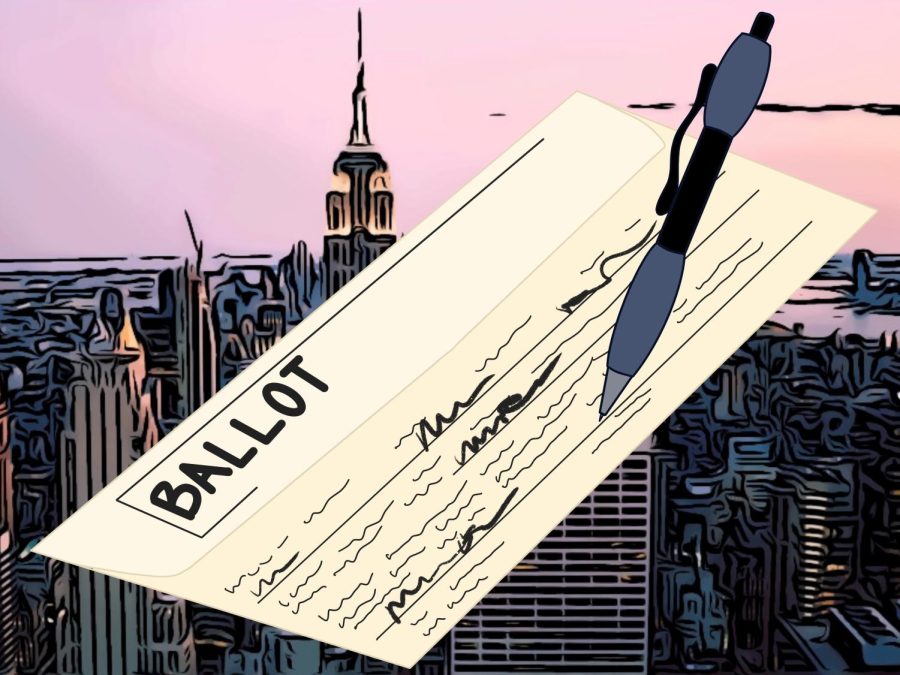Opinion: New York, make it easier to get on the ballot
New York state lawmakers’ efforts to reform ballot access laws highlight the need to make running for office more accessible.
Two Democratic New York State leaders are pushing for a reform bill to abolish complicated ballot access laws and make it easier for aspiring political candidates to get on the ballot. (Staff Illustration by Manasa Gudavalli)
March 4, 2022
Over at New York’s capital, two Democratic state leaders are pushing for legislation to reform the complicated ballot access laws that deter many potential candidates from running for office. The bill that State Sens. Elijah Reichlin-Melnick and Rachel May are backing, which attempts to counteract the obstacles to qualifying for electoral races, underscores the greater importance of changing state ballot access provisions. New York must make running for office more accessible.
Currently, New York upholds a notoriously obstructive setup of election laws and petition requirements dating back to the late 1800s. The present structure aggravates difficulties faced by newcomer candidates attempting to break into local politics. Using the New York City primary election as an example, candidates have a maximum of 37 days to collect a quota of signatures and file their respective Board of Election petitions. This quota is either 5% of registered voters for the previously incumbent political party the office extends to, such as the council district, or the state’s electoral laws’ enumerated amount, depending which bar is set lower. Candidates must also navigate the distinction between eligibility requirements on signing petitions versus collecting signatures, further increasing the requirements candidates must fulfill within a five-week period.
The most significant burden to getting on the ballot, however, is not the time constraint pressures; it is the numerous rounds of — oftentimes arbitrary — challenges posed to candidates’ ballot petitions. On top of the board’s prima facie review of petitions’ validity, any registered voter can question the validity of a candidate’s petitions by writing in objections to the Board of Elections.
These low barriers to challenging a candidate’s signatures create an additional and costly deterrent to running for office. Current regulations force candidates to prioritize withstanding their opponents’ challenges to their signature counts, which are often personally motivated claims that take advantage of technical disqualifiers, such as vague handwriting or the absence of an attributed ZIP code. Energy spent on combating these claims depletes crucial financial resources which could otherwise be spent on actual campaigning and policy development. The effect of such challenges also remains unbalanced based on privilege. Candidates must often depend on election lawyers or political consultants to combat signature challenges, which prevents all but the most well-connected or well-funded candidates from overcoming this obstacle.
“Running for office is extremely challenging, but good candidates are often prevented from even appearing on the ballot because of intentionally obscure rules in the petitioning process,” Sen. May, an upstate Democrat, told Spectrum News 1. “We must make it easier for all New Yorkers to get on the ballot so that more good candidates have the ability to run for office and voters have more choice at the polls.”
The proposed reform bill thoughtfully addresses such tensions in New York ballot access laws by eliminating frivolous signature challenges, such as small errors in a voter’s signed address. The bill also prohibits the invalidation of signatures unless there are fraud allegations or unclear voter identification issues at hand. A Board of Elections official or judge would be responsible for ruling on the candidate’s petition for ballot with the broadest possible interpretation of state election law.
This proposition does fall short, however, in its endorsement of a hastened rejection of a candidate’s petition that does not meet the required number of signatures. This decision grants the petition quota too much political weight and fails to account for the greater inequities candidates must face in order to obtain eligible signatures to begin with. Instead of signatures, filing fees or donations could be used as metrics of demonstrated community support. Of course, such avenues would face their own flaws, but by giving candidates more options for community mobilization it would reduce the risk of ballot-bumping. Regardless of the precise changes to ballot reform access laws, one lesson cannot be ignored: New York state must make it easier for community members to get on the ballot, to ensure the health of our democracy through greater electoral accessibility.
Views expressed in the Opinion section do not necessarily reflect those of WSN, and our publication of opinions is not an endorsement of them.
Contact Michelle Han at [email protected].

























































































































































